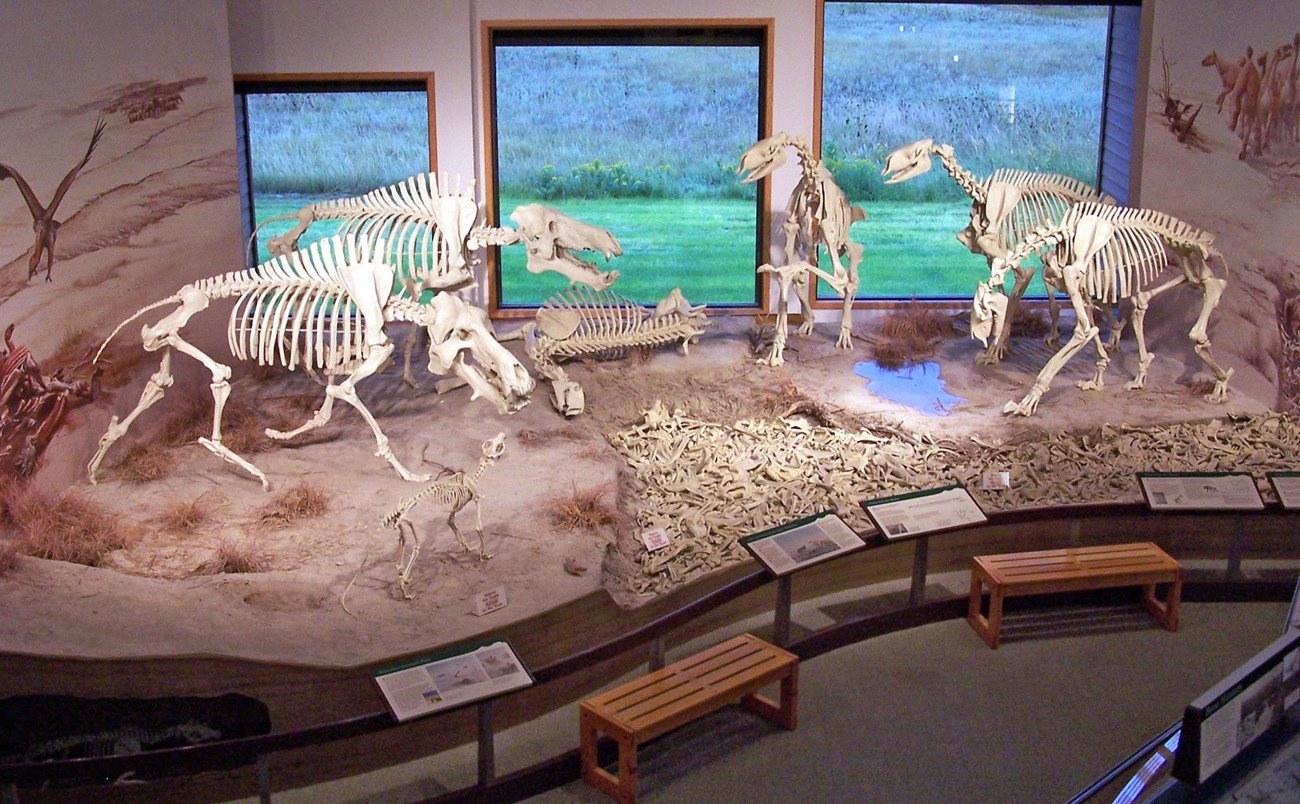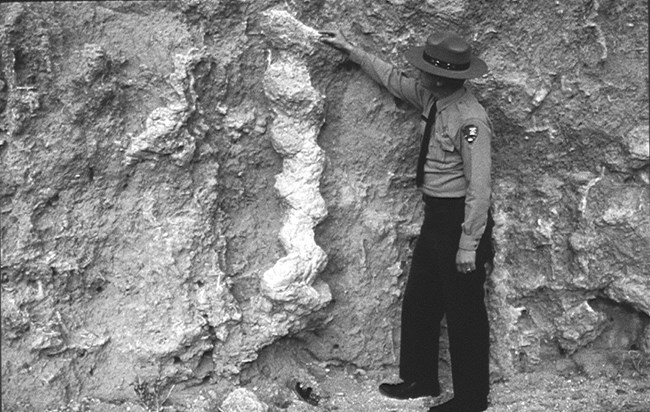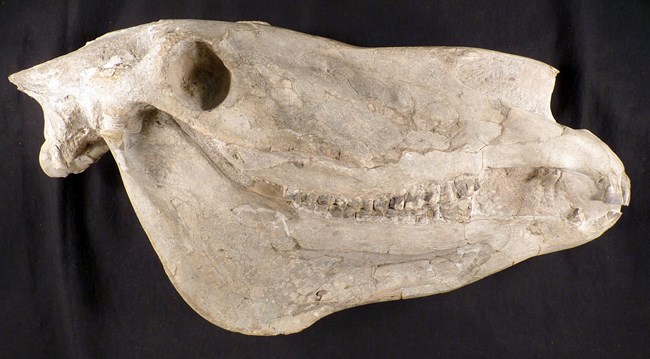Part of a series of articles titled Geologic Time Periods in the Cenozoic Era.
Previous: Quaternary Period—2.58 MYA to Today
Article

NPS image
The Neogene Period is the middle period of the three periods of the Cenozoic Era. Like the other periods of the Cenozoic, it is geologically short (less than 1% of geologic time) but well-represented at the surface. Neogene sedimentary formations are often poorly lithified, because they are young and generally have not been deeply buried. The Neogene Period is divided into two epochs: the Miocene and Pliocene.

NPS image
North America was more extensively submerged in the Miocene than in the preceding Oligocene Epoch and underwent considerable crustal disturbances. The Atlantic and Gulf coasts were flooded about as extensively as in the Eocene Epoch. Miocene rocks are found along the Atlantic as far north as Martha’s Vineyard, but the series, everywhere thin, is thickest and least interrupted from New Jersey to Maryland. On the Gulf Coast, Miocene rocks extend from Florida westward to Texas. Formations along the Atlantic are composed chiefly of marl, clay, and sand, with diatomaceous earth; whereas Florida, having risen as an island in the late Oligocene, is composed of mostly limestone. Along the Gulf of Mexico, formations are a mix of limestone and clastic sediments.
On the Pacific Coast, the Great Valley of California was submerged at the beginning of the Miocene. Formations of this age are found in Santa Monica Mountains National Recreation Area. In mid-Miocene time mountain building was extensive in this region; the Cascade and Coast ranges were elevating. In addition, the first known movement along the San Andreas Fault occurred, reflecting the collision of the North American Plate with the Pacific Plate. Volcanic activity accompanied this disturbance, and in the Pacific Northwest, the Columbia River and Snake River plateaus were formed by flood basalts, which cover an area of more than 200,000 square miles (520,000 km2) with lava flows up to 10,000 feet (3,000 m) thick. This great outpouring of lava in the western interior of North America—along the Columbia River of Washington, Oregon, and northern California, and in northern Nevada and Idaho—continued into the succeeding Pliocene Epoch. The rocks at John Day Fossil Beds National Monument in central Oregon are the result of a succession of alternating fossil-bearing sediments and pyroclastic flows that accumulated during this epoch.
The mammalian life of the Miocene was marked by further stages in the development of the horse, the multiplication and final extinction of the entelodonts (giant extinct relatives of the pigs), and the appearance of the mastodons, raccoons, and weasels. Agate Fossil Beds National Monument preserves a very good fossil record of entelodonts. Cats, camels, dog-like carnivores, and rhinoceroses were common in North America. In the Miocene a distinct cooling of the climate resulted in the reduction of forests and an increase in grassy plains.

NPS image
By the beginning of the Pliocene Epoch, the outlines of North America were almost the same as today. Encroachments by the sea were limited to a narrow strip along the coasts of the Carolinas, Georgia, Florida, and the Gulf Coast states, and an embayment, smaller than that of the preceding Miocene Epoch, in California. Pliocene rock formations on the Atlantic Coast are chiefly marine marl; on the Gulf they are non-marine sediments resulting from erosion. In California they contain volcanic ash and sometimes oil. The Pliocene formations of the western interior are small and scattered. One of these formations, the Glenns Ferry Formation, is found on the Snake River Plain at Hagerman Fossil Beds National Monument. In the western interior of North America and on the West Coast, volcanic activity beginning in the Miocene continued into the Pliocene. Ash from frequent volcanic eruptions, which can be accurately dated through radiometric dating, is widely distributed in formations in the West. In North America, uplift of the Cascade Range and the Sierra Nevada being elevated and tilted to the west marks the close of the Pliocene Epoch. Active uplift took place in the Rocky Mountains, the Colorado Plateau, the mountains of Alaska, and the Great Basin ranges of Nevada and Utah. The climate of the Pliocene was markedly cooler and drier than that of the Miocene and foreshadowed the glacial climates of the Pleistocene Epoch.
Life in the Pliocene is notable for its modern appearance. Among the first of these forms is the earliest species of the modern horse genus, Equus. During the Pliocene the formation of the Isthmus of Panama allowed animals to move between North and South America. Animals of South American origin such as ground sloths, armadillos, glyptodonts (superficially similar to armadillos), porcupines, and capybaras (large rodents) first appeared in North America, and North American forms like llamas and tapirs entered South America for the first time.
During the Neogene, mammals and birds evolved considerably. Most other life-forms were relatively unchanged. A notable evolutionary path is that of hominids, which occurred during the Neogene.
Studies in evolutionary biology have led to the conclusion that human beings arose through organic evolution from ancestral primates. This association was hotly debated among scientists in Darwin’s day, but today there is no scientific doubt about the close evolutionary relationships among all primates, including humans. To be clear, however, humans did not evolve from modern apes. Rather, humans and modern apes share a common ancestor, a species that no longer exists. Because we share a recent common ancestor with chimpanzees and gorillas, we have many anatomical, genetic, biochemical, and even behavioral similarities with the African great apes. We are less like the Asian apes (e.g., orangutans and gibbons) and even less similar to monkeys because our common ancestors with these groups are in the more distant past (Kennedy et al. 1998).
The word “hominid” refers to a member of the family, Hominidae, which consists of great apes and humans. Until recently, most classifications included only humans in this family; other apes were put in the family Pongidae (from which the gibbons were sometimes separated as the Hylobatidae). The evidence linking humans to gorillas and chimps has grown dramatically in the past two decades, especially with increased use of molecular techniques. It now appears that chimps, gorillas, and humans form a clade or group of closely related species. Orangutans are slightly less close phylogenetically, and gibbons are a more distant branch. Thus constituted, the Hominidae includes four genera and five species. Its nonhuman members are restricted to equatorial Africa, Sumatra, and Borneo. Hominid fossils date to the Miocene Epoch and are known from Africa and Asia.
Many of the most important advances in paleontology over the past century relate to the evolutionary history of humans. Investigators have found not one but many connecting links (fossils) that are intermediate between and along various branches of the human family tree. Natural selection and genetic mutations over the last 6 million years have resulted in our species, Homo sapiens sapiens.
Every park contains some slice of geologic time. Here we highlight a few parks associated with the Neogene Period. This is not to say that a particular park has only rocks from the specified period. Rather, rocks in selected parks exemplify a certain event or preserve fossils or rocks from a certain geologic age.
Big Bend National Park (BIBE), Texas—[BIBE Geodiversity Atlas] [BIBE Park Home] [BIBE npshistory.com]
Channel Islands National Park (CHIS), California—[CHIS Geodiversity Atlas] [CHIS Park Home] [CHIS npshistory.com]
Colonial National Historic Park (COLO), Virginia—[COLO Geodiversity Atlas] [COLO Park Home] [COLO npshistory.com]
Death Valley National Park (DEVA), California, Nevada—[DEVA Geodiversity Atlas] [DEVA Park Home] [DEVA npshistory.com]
Hagerman Fossil Beds National Monument (HAFO), Idaho—[HAFO Geodiversity Atlas] [HAFO Park Home] [HAFO npshistory.com]
John Day Fossil Beds National Monument (JODA), Oregon—[JODA Geodiversity Atlas] [JODA Park Home] [JODA npshistory.com]
Joshua Tree National Park (JOTR), California—[JOTR Geodiversity Atlas] [JOTR Park Home] [JOTR npshistory.com]
Lake Mead National Recreation Area (LAKE), Nevada and Arizona—[LAKE Geodiversity Atlas] [LAKE Park Home] [LAKE npshistory.com]
Mojave National Preserve (MOJA), California—[MOJA Geodiversity Atlas] [MOJA Park Home] [MOJA npshistory.com]
Niobrara National Scenic River (NIOB), Nebraska—[NIOB Geodiversity Atlas] [NIOB Park Home] [NOIB npshistory.com]
Organ Pipe Cactus National Monument (ORPI), Arizona—[ORPI Geodiversity Atlas] [ORPI Park Home] [ORPI npshistory.com]
Santa Monica Mountains National Recreation Area (SAMO), California—[SAMO Geodiversity Atlas] [SAMO Park Home] [SAMO npshistory.com]
Part of a series of articles titled Geologic Time Periods in the Cenozoic Era.
Previous: Quaternary Period—2.58 MYA to Today
Last updated: April 27, 2023